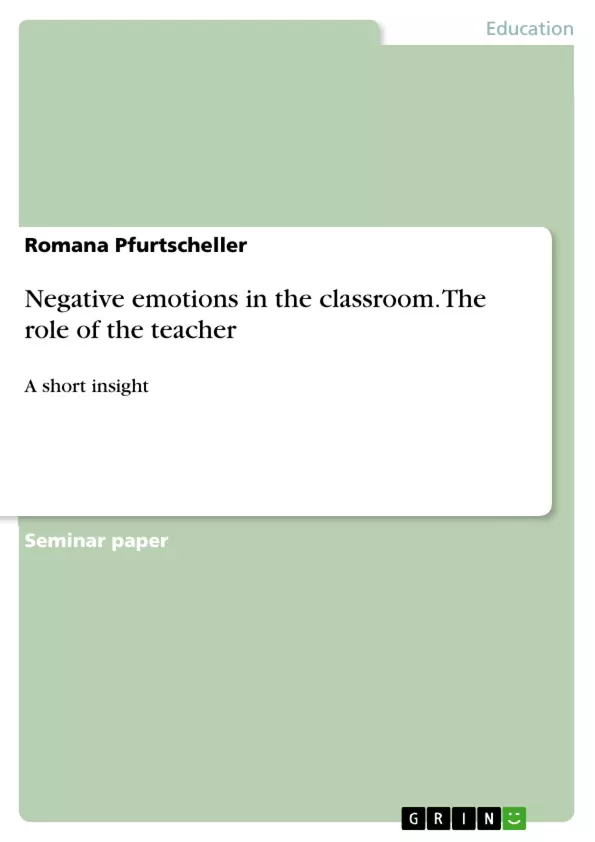In this paper the phenomenon of the subject of negative emotions in the classroom will be discussed.
At the beginning there will be a clarification of the term emotions in general, which also includes negative emotions and how these can be manifested in the classroom by both parties involved and which situations may lead to the development of negative emotions. Connecting to that, there will be a discussion about the teacher perspective of coping with their negative emotions, which includes stress management and regulation, and also the avoidance of developing negative emotions as a teacher.
Following that, the perspective of the students, on how teachers display their negative emotions in the classroom will be discussed, as students might have a different view on how they perceive the expressions of their teacher. As result of that, a link between the misbehaviour of the students and the reaction of the teachers will be briefly explained. To close the paper, there will be a short conclusion about the topics mentioned above.
Inhaltsverzeichnis (Table of Contents)
- Introduction
- Emotions
- How negative emotions can be manifested in the classroom
- Which situations can lead to the outcome of negative emotions
- Teachers perspective of coping with their negative emotions
- Stress management of teachers
- Preventing the development of negative emotions
- Students perspective of coping with negative emotions
- Link between students' misbehaviour and teachers' reaction
- Conclusion
Zielsetzung und Themenschwerpunkte (Objectives and Key Themes)
This seminar paper explores the phenomenon of negative emotions in the classroom, focusing on their manifestation, causes, and coping mechanisms for both teachers and students. It aims to provide insights into the emotional dynamics of the classroom environment and the impact of negative emotions on teaching and learning.
- The nature and manifestation of negative emotions in the classroom
- Situations that trigger negative emotions in teachers and students
- Teacher strategies for coping with negative emotions, including stress management and prevention
- The student perspective on teacher emotions and its influence on their behaviour
- The connection between student misbehaviour and teacher reactions
Zusammenfassung der Kapitel (Chapter Summaries)
- Introduction: This chapter sets the stage by emphasizing the significance of emotions in human interaction, particularly within the classroom context. It introduces the main focus of the paper: negative emotions in the classroom.
- Emotions: This chapter defines emotions as a complex process consisting of appraisal, subjective experience, physiological changes, emotional expression, and action tendencies. It explores how differing appraisals and emotional responses can influence classroom interactions and relationships between teachers and students.
- How negative emotions can be manifested in the classroom: This chapter delves into the different ways in which negative emotions can be displayed in the classroom, linking them to the four components of the emotion process. It highlights how physiological changes, such as facial expressions and changes in heart rate, can manifest negative emotions in both teachers and students.
- Which situations can lead to the outcome of negative emotions: This chapter explores various situations that can trigger negative emotions in both teachers and students. It discusses how teacher-student interactions, particularly communication behaviours, can influence the development of negative emotions and student engagement.
- Teachers perspective of coping with their negative emotions: This chapter examines teacher perspectives on coping with negative emotions in the classroom, highlighting the two most common emotions: anger and frustration. It explores how these emotions can arise from disruptions to personal goals and how teachers can manage and prevent their occurrence.
Schlüsselwörter (Keywords)
This seminar paper focuses on the key concepts of negative emotions, classroom environment, teacher-student interaction, emotional regulation, stress management, and coping mechanisms. It examines how these concepts contribute to the complex dynamics of the classroom, influencing teaching and learning experiences.
- Citar trabajo
- Romana Pfurtscheller (Autor), 2018, Negative emotions in the classroom. The role of the teacher, Múnich, GRIN Verlag, https://www.grin.com/document/947256



